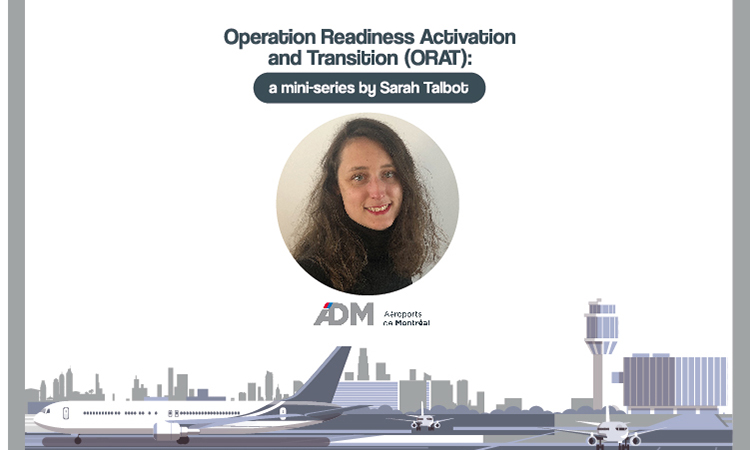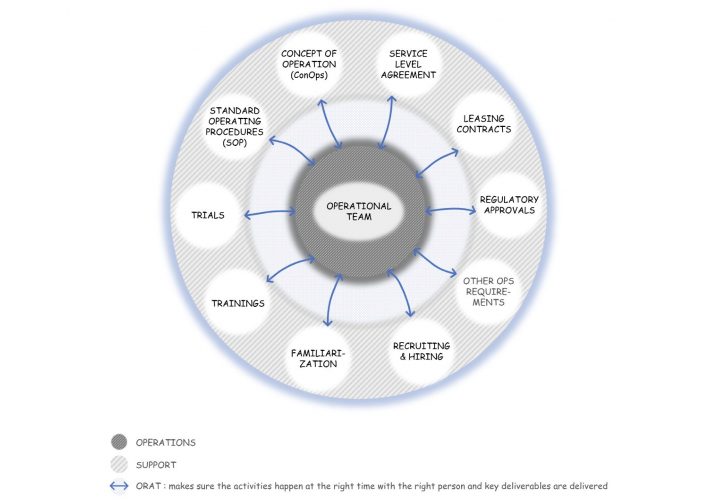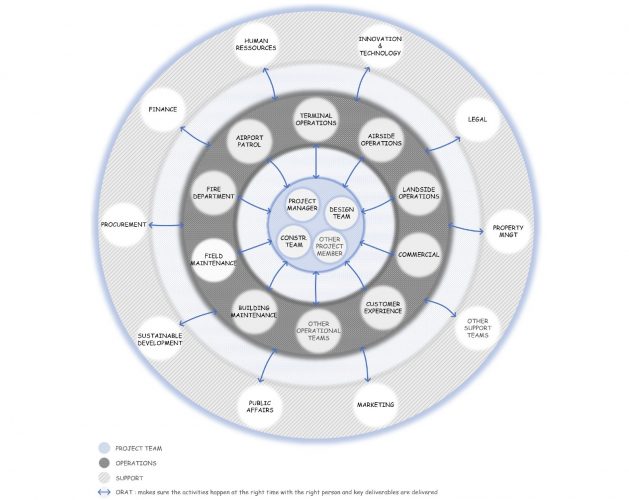Understanding ORAT and why airports need to get on board
- Like
- Digg
- Del
- Tumblr
- VKontakte
- Buffer
- Love This
- Odnoklassniki
- Meneame
- Blogger
- Amazon
- Yahoo Mail
- Gmail
- AOL
- Newsvine
- HackerNews
- Evernote
- MySpace
- Mail.ru
- Viadeo
- Line
- Comments
- Yummly
- SMS
- Viber
- Telegram
- Subscribe
- Skype
- Facebook Messenger
- Kakao
- LiveJournal
- Yammer
- Edgar
- Fintel
- Mix
- Instapaper
- Copy Link
Posted: 24 May 2021 | Sarah Talbot | 7 comments
In the first instalment of a new and exclusive mini-series for International Airport Review, Sarah Talbot, Project Manager and Airport Planner at ADM Aéroports de Montréal, discusses what ORAT is and why it is of such importance for airports.


What is ORAT, and how can it be applied to your airport? This is one of a short series of articles that will provide you with everything that you need to know about ORAT. As a starting point, we will dive into what ORAT truly means. Our second article will then focus on ADM Aéroports de Montréal’s approach to ORAT. Finally, the last piece will guide you on how to implement ORAT in your airport, and how to adapt ORAT to a post-COVID-19 reopening.
What is ORAT?
There are different interpretations of ORAT’s acronym: Operational Readiness Activation and Transition, or Operational Readiness and Airport Transfer, for example. In the end, the objective remains the same: to operate your new facility on day one as if you have operated it for years. It was created to ease the transfer from a construction site to an operating facility; some may say from a static to a dynamic state.
Construction management projects are known for their ‘on time, on budget’ approach. Some add on scope or quality. ORAT brings a fourth angle: operational readiness. To consider the project successful, users must be comfortable with the operating mode before opening. It adds something to think about when preparing the project, but, ultimately, users are more efficient, faster.
ORAT introduces in the construction project management strategy the idea of ‘state’. In addition to targeting a delivery date, the project aims for an acceptable state that is agreed and understood by all. As for any project management, timeline and budget are important. However, ORAT goes beyond the lighting fixtures and the furniture installation. The ability of the users to operate the facilities during normal activities, contingency and emergencies is also considered as a deliverable by the project team.
Therefore, what is the difference between ORAT and commissioning? Commissioning is a part of ORAT thatcovers a wider range of activities. Technical, equipment and systems readiness are an important part of the transfer andare probably the most common. Do not mix up start up tests with commissioning. Traditionally known as ‘final checks’, commissioning has evolved into a process that includes integrated trials, optimisation of the building energy performance, documentation and staff training. ORAT covers those activities and does more than training on equipment and systems. As commissioning is historically associated with maintenance, ORAT oversees the preparation of all regular airport operations, as well as commercial operations, contingency plans and emergency plans. ORAT anticipates everything that may happen after the contractor is gone. While situations and events’ readiness play an important part in ORAT, behavioural readiness is crucial.


Figure 1: Operational Readiness. Credit: Sarah Talbot, Aéroports de Montréal.
Stakeholders
One may think that ORAT is an additional step in the project between construction and operation. Most, if not all, ORAT specialists agree that ORAT should be involved during each step of the project and implemented as early as during the planning phase. Why is it important to integrate people long before construction has even started? Why don’t we just plan familiarisation sessions after the contractor is gone, before opening?
ORAT is a change management process: the new facility or the new infrastructure usually comes with more than new walls or concrete slab, it comes with new systems, new equipment, new regulations, new processes, new routes for users, new requirements for employers, new questions from passengers and so on. Like many change management strategies, ORAT promotes the engagement of stakeholders early in the project process. It brings the project management and operating teams together to work throughout the planning, design, construction and transfer phases.
ORAT tends to engage stakeholders in the project instead of simply managing them. While many attach importance to needs’ identification and scope definition during the planning phase, we often hear at the end of a construction project: “We did what you asked for, here are the keys, now operate it”, often resulting in user dissatisfaction.
By working with stakeholders throughout the project, it eases the common understanding of project objectives and the development of aligned strategies to achieve them. It also allows to make quick adjustments on the site reducing costs, compared to waiting for the end of the project. Furthermore, it helps operational teams to understand the schedule and to prepare their activities accordingly, including: operational procedures, contingency plans, HR recruitment, service agreement, trials, training and familiarisation sessions.
Working with stakeholders early in the project may lengthen the project schedule compared to a traditional construction schedule. On the other hand, it will reduce the waste of time for operations later and reduce the risk of needing another project to compensate for the first incomplete one.
ORAT team
Planners plan, designers design, builders build, operators operate and project managers focus on time and cost. ORAT oversees project development, assuring that the needs are integrated accordingly and that the staff can operate the facility from day one.
Now, who pilots ORAT? Depending on airport size, organisational structure, project size and project complexity, ORAT can be done internally or the activities can be subcontracted. Many consulting firms now offer ORATservices. It can even be a hybrid of in-house and external resources. Even if ORAT coordination is entirely subcontracted, it is highly recommended to work with the end user to develop the operations plans.
Another good practice is to make ORAT part of the project team instead of an external player, involving them in the schedule, budget, risk analysis, value-analysis or value-engineering.
Having someone in the ORAT team who understands the construction project reality and who is operations-oriented is beneficial, as the person can translate to both realities.


Figure 2: ORAT’s relations. Credit: Sarah Talbot, Aéroports de Montréal.
Done properly, ORAT can contribute to sustainability, as it adds to life cycle analysis. By including ORAT early in the project, it will decrease the risk of changes during construction, and it will lower the post-opening modifications, which should result in less deconstruction and material loss. It will support commissioning in its attempt of being a, if not the most, cost-effective strategy for reducing energy, costs and greenhouse gas (GHG) emissions in buildings. It will also include stakeholders early in the process, helping to work their concerns out with them. In short, it will contribute to making the project right, but, even better, it will help to make the right project.
Sarah Talbot is an architect who has been evolving in the airport business for almost 15 years. She worked as a consultant before joining ADM Aéroports de Montréal as a project manager and airport planner. Operations- and sustainability-oriented, she now leads the ORAT programme for major infrastructure projects and supports teams for its implementation throughout ADM.
ADM Aéroports de Montréal is the airport authority for the Greater Montréal area, responsible for the management, operation and development of Montréal-Pierre Elliott Trudeau International Airport (YUL), certified as four stars under the Skytrax World Airport Star Rating programme, and Montréal-Mirabel International Airport (YMX).
Related topics
Airport construction and design, Airside operations, Emissions, Sustainability, Sustainable development, Terminal operations, Workforce



















Top and very interesting
Article super intéressant.
ORAT=Augmentation de la chance de succès d’un immense projet à condition que toute l’équipe et tous les acteurs remplissent leurs rôles.
Excellent article, these will help us to explain why ORAT is so important .
Cheers from Panama
PTY
I found this article very comprehensive and useful. It would be interesting to add some concrete ”real life” examples in the next publications of this mini-series.
The article gives essential insight of ORAT. Other articles of this series would help implementing ORAT in my airport. Heartfelt thanks to Sarah Talbot for posting the article online. May God bless you.
very informative and refreshing article
Muy interesante y aleccionador el articulo.